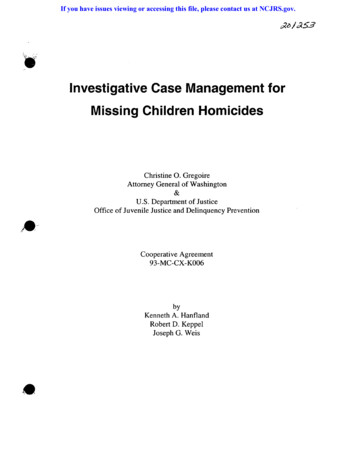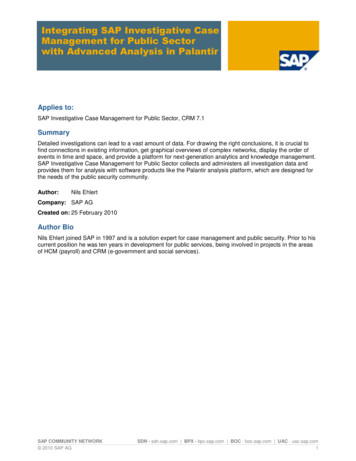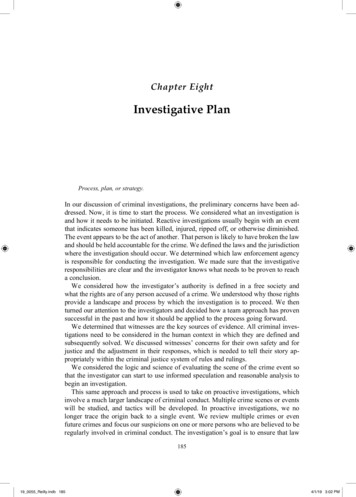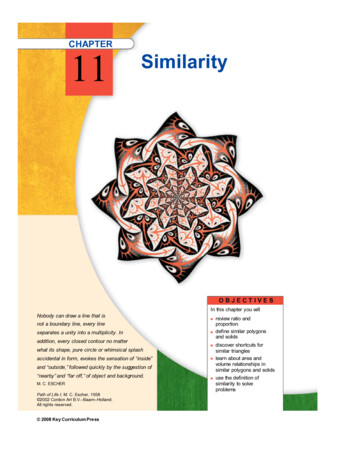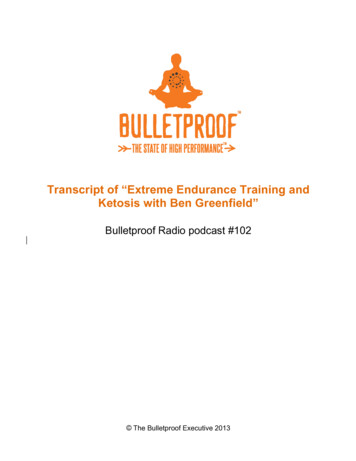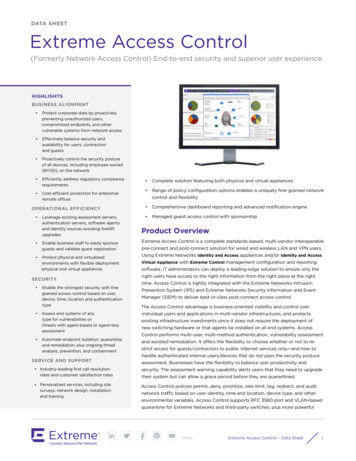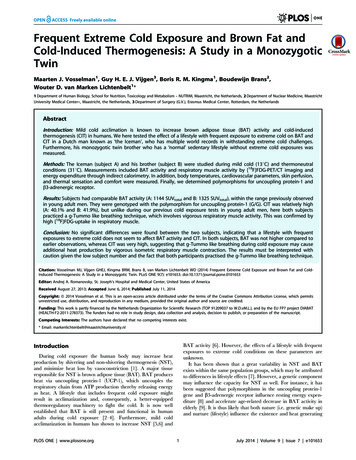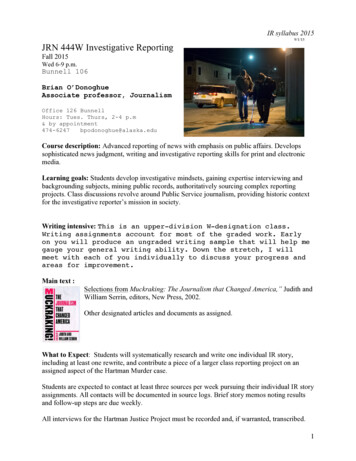
Transcription
IR syllabus 20159/1/15JRN 444W Investigative ReportingFall 2015Wed 6-9 p.m.Bunnell 106Brian O’DonoghueAssociate professor, JournalismOffice 126 BunnellHours: Tues. Thurs, 2-4 p.m& by appointment474-6247bpodonoghue@alaska.eduCourse description: Advanced reporting of news with emphasis on public affairs. Developssophisticated news judgment, writing and investigative reporting skills for print and electronicmedia.Learning goals: Students develop investigative mindsets, gaining expertise interviewing andbackgrounding subjects, mining public records, authoritatively sourcing complex reportingprojects. Class discussions revolve around Public Service journalism, providing historic contextfor the investigative reporter’s mission in society.Writing intensive: This is an upper-division W-designation class.Writing assignments account for most of the graded work. Earlyon you will produce an ungraded writing sample that will help megauge your general writing ability. Down the stretch, I willmeet with each of you individually to discuss your progress andareas for improvement.Main text :Selections from Muckraking: The Journalism that Changed America,” Judith andWilliam Serrin, editors, New Press, 2002.Other designated articles and documents as assigned.What to Expect: Students will systematically research and write one individual IR story,including at least one rewrite, and contribute a piece of a larger class reporting project on anassigned aspect of the Hartman Murder case.Students are expected to contact at least three sources per week pursuing their individual IR storyassignments. All contacts will be documented in source logs. Brief story memos noting resultsand follow-up steps are due weekly.All interviews for the Hartman Justice Project must be recorded and, if warranted, transcribed.1
IR Syllabus 2014From time to time, the class will take field trips to crime scenes and the courthouse.Grading:Final grades calculated using UAF's plus-minus, 10-point scale, applying this weighting:IR stories: 50 percentStory memos: 20 percentSource logs: 10 percentReading quizzes: 10Final: 10 percentNote: Writing assignments make up approximately 70 percent of each student’s overall grade.EXTRA! EXTRA! Students who earn an IR story byline in the News-Miner, or other commercialoutlets, receive extra credit. Publication of class assignments in the Sun Star, or any other studentpublication, may also qualify for a bonus. Effort above and beyond what's expected in the classprojects may also merit extra credit.Standards and expectations:Deadlines: Assigned reading must be completed before class Tuesday. Weekly logs and storymemos are due Wednesday nights by 9 p.m., enabling me to digest them in time for classdiscussion Thursday. Late work is penalized at least one-half grade and may be rejected.When I say tape Hartman Project interviews, I mean it. Use your cellphone video. Buy batteries for audio reorders on the way.If I request a full or partial transcript, do it. The stakes are high. Nobodykeeps perfect notes. Transcripts often hold clues of belated significance.How to succeed in JRN 444:Investigative reporting is the hallmark of journalists who won’t settle for less than the full storyabout events, issues, trends or personalities influencing society. This class is about reporting andwriting complex stories. Continuing effort trumps sporadic attention. Aim high pursuing storiesof consequence. Be bold tracking down sources and diligent writing up story memos and loggingsources while the material is fresh. Take note of the investigative techniques applied by others asyou read the product of their efforts.Factual errors: Check and double check proper names, job titles, dates and all other facts beforeturning in assignments. There’s no excuse or errors in IR rewrites. The smallest flaw underminescredibility, tainting otherwise solid reporting and captivating prose.Ye olde BOILER PLATE warnings:“DANGER, DANGER WILL ROBINSON!”Plagiarism is appropriating someone else’s words and presenting them as your own.2
IR syllabus 2015It's fair game for a reporter to quote newspapers, magazines, TV reports ormaterial obtained from credible Web sources. BUT it's plagiarism to do so withoutproper attribution and appropriate quote marks. Evidence of plagiarism will resultin a "F" on any assignment. Further sanctions are possible.Fabrication is making up a quote, a source or an event; in other words presenting asreal something that did not occur or does not exist. This is a firing offense, a likelycareer ender, warrants an "F" for the course and possible expulsion from the UAFJournalism program.Attendance is mandatory: Baring a documented emergency, illness or prior arrangements withthe professor, missed quizzes and other in-class work cannot be made up.Copy: Double space and e-mail as MS WORD or Open Office documents. If appropriate,include supporting photos, audio or graphics. Submit source logs as spreadsheets.Style: The AP Stylebook is our guide.Communications: E-mail is best for submitting assignments or asking questions. Usedescriptive subject lines. And don't expect an immediate responseCELL PHONE FREE ZONE:Turn off phones and other messaging devices during class. Notexting. No kidding. If you must, take it outside the classroomas unobtrusively as possible.Newsroom etiquette: Candor and informality is encouraged, not mean-spirited jabs, profanity oroff-topic tangents. Students who exceed the bounds taste will be curbed.Anyone uncomfortable with the nature and direction of class discussions should contact theprofessor privately.SPECIAL NEEDS?Take advantage of UAF’s free support services:I can make reasonable accommodations for individuals with documented disabilities, forexample, arranging for an in-class note taker or providing a quiet test-taking environment. SeeDisability Services for a letter recommending the kind of assistance you need to be successful.More options are open early in the semester. Notify me about possible special needs within thefirst two weeks.Disability Servicese-mail. fydso@uaf.edutel. 907-474-5655tty. 907-474-1827Whitaker Building Room 208www.uaf.edu/disability3
IR syllabus 2015Writing CenterDept. Of English801 Gruening Bldg.(907) 474-5314faengl@uaf.eduSpeaking CenterDept. of Communication507 Greuning Bldg.(907) 474-5470fyspeak@uaf.eduAny student I suspect may benefit will receive mandatory referrals.The centers provide this and more:The Speaking Center is a student-oriented service that helps preparing public presentations.Assistance areas include refining topics, organizing material and practicing presentation. TheCenter makes it possible to digitally record and to watch one's practice presentation, receivingconstructive feed back from a Speaking Center coach.The Writing Center, a student-staffed, student-oriented service of the English Department, assistswith any phase of the writing process -- planning, drafting and revising. Discover ways ofimproving grammar, mechanics, and punctuation.More options are available early in the semester, so don’t be shy.--30--Personal mission disclosure: The race is on!Some 35 years ago I set sights on making my mark as a roving photojournalist. The summer of ’79 thatambition led me to Cairo where I landed work as a UPI stringer.My images of a harried President Anwar Sadat, Egyptian-Israeli summits andother breaking stories turned up in papers around the world. I was on my way-doing exactly what I dreamed.And it proved disappointing.Everywhere I trained my lens, I saw stories that demanded fuller, richer context.In those days, a photographer seldom initiated assignments, particularlyanything involving reporting in depth.I was in Alexandria shooting peace talks when a free call home—courtesy ofABC news—brought word that my father, then 48, had suffered a massive stroke.1
IR Syllabus 2014His eyes signaled awareness when I reached the hospital room, but aphasia had stripped my dad of speech,pervasive right-side paralysis rendered him essentially helpless. Patrick C. O’D, leading Labor lawyer, nationalcounsel for the pipefitters, iron workers and elevator mechanics unions, among others died within 10 weeks.Back in the states, I broadened my approach, writing stories to go with my photos for alternative weeklies inD.C., Baltimore and New York. By 1985, I had added a MA in broadcast journalism from New York Universityto my camera bag.A staff job as a reporter/photographer at the Frontiersman in Wasilla brought me to Alaska in time to witnesseffects of crashing oil revenues. I began experimenting with larger issue stories through “Million Dollar Milk,” aseries exploring Alaska’s ill-fated Point MacKenzie dairy project. Over time, I developed expertise ininvestigative reporting, tackling ever more complex stories at the Fairbanks Daily News-Miner and AnchorageDaily News. I suffered the travails of managing special projects involving other reporters, and experiencedwhat it takes to finish and publish books.What I knew about IR came through trial and error. In 2002, I discovered Investigative Reporters and Editors,an organization of reporters and editors dedicated to news stories providing context, “the best available truth,”as Carl Bernstein puts it, about important, often messy issues of importance to the public.My innate sense of journalism’s mission benefited from IRE’s research tools andstorytelling strategies. Everything I’ve learned since is reflected in my ongoing HartmanJustice Project. The stakes are huge: No Justice for the hapless teen victim, four otheryoung lives ruined, a community’s faith shattered, truth held legal hostage, all of whichpoints to broken legal system that’s only now paying attention because of UAFJournalism’s contributions in the court of public opinion.It’s not enough to make headlines. Public Interest needs watchdogs willing to go beyond identifyinginstitutional failures, forcing government to deliver on its constitutional promises.My own inspiration to keep going where others quit—chasing elusive documents or finishing a stormyIditarod—reflects urgency. Our time here is finite. Make yours count.--Brian Patrick O’DonoghueThat file you need lurks in the one folder left to check, count on it.
Publication of class assignments in the Sun Star, or any other student publication, may also qualify for a bonus. Effort above and beyond what's expected in the class projects may also merit extra credit. Standards and expectations: . faengl@uaf.edu Speaking Center Dept. of Communication 507 Greuning Bldg. (907) 474-5470 fyspeak@uaf.edu
